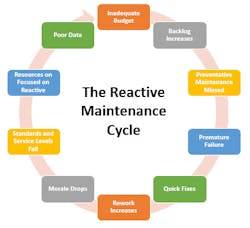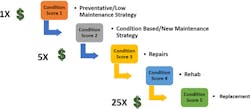Getting a Grip on Asset Management: The Web GIS Centric Approach
The US and Canada face tremendous capital outlays to repair and replace aging municipal and utility infrastructure. A computerised maintenance management system can provide the insight to drive capital asset renewal and replacement budget accurately.
By Gregory Baird
In recent years, municipalities and water and wastewater operators have struggled significantly in managing the complex and diverse assets that are within their jurisdictions for which they are accountable.
Municipalities and utilities at all levels have faced severe revenue short falls during the Great Recession 2007 through to 2013. During this time frame, local governments first reacted by freezing vacant positions and then continued with staff reductions and later severe budget cuts. Even a “same budget as last year” was a budget cut due to inflation and an “across the board” budget cut lacked proper prioritization not considering service levels and needs. These conditions have caused many organisations to fall into the Reactive Maintenance Cycle.
The actions taken to maintain basic services involved delaying hundreds of millions of dollars a year in needed maintenance activities and deferring critical asset renewal and replacement capital projects. As a result of not funding maintenance activities, many assets are now falling below their service levels and failing prematurely not reaching their intended performance life. T
De Sitter Law states:
- If you do not do normal maintenance, you will be required to do repairs, which will cost five times more than normal maintenance.
- If you do not do repairs, you will have to replace, which will cost five times more than repairs.
- Therefore, replacement costs 25 times more than normal maintenance.
Siloed data
As expected, municipalities and utilities have seen a drastic increase in both maintenance costs and capital replacement needs as the condition of assets continue to decline.
Efforts made at the state, regional, county and local levels to better manage assets and allocate limited resources to failing assets are currently being met with a high degree of frustration. This is due to inconsistent and outdated maintenance practices, neglected asset and cost data tracking and storage, and a lack of data integration abilities with silo/stranded data throughout many departments.
Finance managers are also in shock and disbelief of the increase in funding requests. The incremental single digit inflationary annual budget increases of the past are no longer sufficient to properly maintain poor performing assets while still meeting expected service levels. Operations and maintenance budget forecasts are also being distorted as cost projections are being calculated from a high unplanned work order percentage which costs more than planned work maintenance activities. Unplanned, reactive or emergency costs can average as much as three times or more than a planned work maintenance activity.
Without the measurement of asset costs and operational and maintenance activities, an organisation’s budget planning process will fail to report whether the allocated funding is sufficient. When there is no true measurement or analysis, there can be no control process and thus no continuous improvement. Without consistent and accurate projections, an organisation will not be able to determine if they are financially sustainable. Furthermore, if the asset is poorly designed, constructed, installed or operated, the maintenance cost curve can have a significantly different shape. Benchmarking and improving record keeping and data accuracy is critical in order to develop a business improvement process to track and report performance goals.
The US Environmental Protection Agency (EPA) reported that 30-70 percent of equipment maintenance activity is typically misdirected and is not cost effectively deterring failure. Also, many times an organisation is also not actually performing the scheduled maintenance activity which makes a review of “over/under” maintenance and a change in its condition score very important. Infrastructure asset management programs should be focused on managing assets in a way in which the investment for each asset can be optimised producing overall cost savings in both operations and capital budgets. Traditional asset management in the US seems to have focused only on asset renewal and prioritising capital projects. However, the heart of the asset life cycle is the operating and maintenance stage.
A computerised maintenance management system (CMMS) is the core engine of asset data collection, storage, analysis and execution of operational and maintenance strategies and activities. An Esri ArcGIS centric CMMS shares the geodatabase as a single asset repository, leveraging it with an architecture web map platform to provide spatial geo-analytical insight into asset criticality proximity, risk mitigation, resilience planning, and multisector asset management analysis and coordination.
Combined with a web GIS centric CMMS, the software enables municipalities and utilities to manage public assets and urban services seamlessly while being responsive to citizen inquires and concerns in a cost justified process. Esri GIS based asset management business processes and software applications and tools connecting field services for public works and utilities to decision makers is at the core of emergency services and disaster recovery efforts building community resilience. Every process and tool used in asset management and maintenance management such as service requests, work orders, inspections, 311 systems, field device mobility, online maps, real-time data and financial cost reporting are engaged at a high speed, mission critical level during FEMA emergency management recovery efforts.
Smart utilities
A “Smart” municipality or “Smart” utility can be defined as an urban planning development concept or vision to combine information technologies and the Internet of things (IoT) products to connect and manage public assets and services. In part, this is achieved by collecting ‘near’ real-time data to enhance and improve the quality of life of citizens. Smart city and utility objectives include customer service interconnectivity and a reduction in the costs of services provided by reducing ineffective resource consumption and government inefficiencies. IoT in conjunction with a well configured Esri GIS centric CMMS can reduce response and resolution times from hours and days to minutes and hours.
In 2016, a comparative review of the major computerised maintenance management and infrastructure asset management systems used by municipal governments and water and wastewater utilities in the US and Canada was released. This was an update to the previous 2012 evaluation.
The comparative criteria included software costs, vendor services, support, specialization, work orders, inventory control, licensing and permitting, condition assessment, risk management, asset inventory, GIS mapping, Esri GIS integration, 311 systems, mobile devices while emphasizing the industry trend of the Esri GIS platform and Return on Investment.
Risk by virtue
In the US and Canada, the definition of asset management may continue to be influenced by the software tools each organisation selects as a means to improve asset performance and to manage costs. Any investment in asset management practices will produce a reduction in asset costs and risk by virtue of knowing and understanding what assets are owned, the location and condition. Logic dictates that if an asset is not maintained correctly it can fail prematurely. Likewise, an asset replaced prematurely wastes a useful asset and as a result, improved performance and prudent investment decision making does not occur.
A CMMS should provide the critical data and intelligence about assets which drives the capital asset renewal and replacement budget. A CMMS work history should be used as justification and vetting of current year proposed capital improvement projects that may have been part of the capital budget plan for years. The system is an important part of an overall asset management framework and can be used in a consistent manner for performance and benchmarking and as part of an organisation’s management-wide effort to guide investments and effective resource allocation.
As well as the CMMS, informed decision making can reduce the overall cost of the asset to the benefit of the tax and rate payers. This process is data intensive and requires the necessary policies, leadership and structure to meet sustainable infrastructure objectives. The goal to achieve a sense of sustainable infrastructure requires an overall planning effort including asset management plans, a financial plan, a risk management plan, a technology plan, a service delivery plan, and integration with community planning and communication efforts.
Asset management professionals understand these concepts and can provide a holistic perspective with the ability to customise solutions to each municipality or utility. These professionals possess the expertise in and understanding of the International Infrastructure Management Manual (IIMM) as published by IPWEA (The Institute of Public Works Engineering Australasia), which is essentially the bible of asset management.
The IIMM combined with the ISO 55000 framework is critical in establishing the foundational knowledge of the comprehensive process of modern asset management. The basic premise should be that integrated infrastructure asset management is a process of continuous improvement and change to evaluate the planning, management, risk and cost of assets. A GIS centric CMMS can provide the core data, insight and analysis and business process work flows, which support the development of asset management plans as recommended by the IIMM for communicating infrastructure plans and needs.
CMMS and Infrastructure Asset Management Software implementation trends for municipalities also suggests a high need for all business enterprise funds like water, wastewater, reuse and storm drains to use formal software packages which can then be applied citywide.
Sustainability and infrastructure asset management practices and business process improvements flow to the general city management counterparts of public works, facilities, fleet, parks, signage, bridges, cemeteries, airports, ports and marinas. This citywide asset management migration trend will continue and can be more readily managed with a suitable web platform centered strategy.
Author’s note: Gregory Baird is a municipal finance professional and creator of the Wet Infrastructure Resource Solution Center. The article is based on the study: The 2016 Comparative Review of Municipal Maintenance and Infrastructure Asset Management Systems.
More Water & WasteWater International Archives Issue Articles



